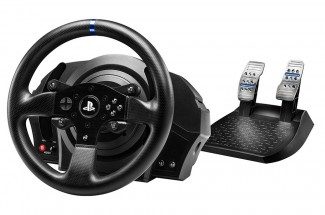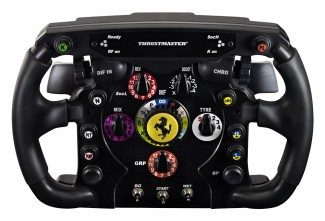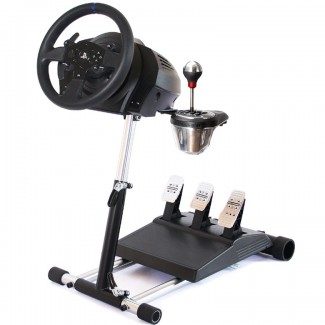Haptic feedback is one of the toughest challenges for general-purpose VR input, but for the driving simulation genre, dedicated controllers have been addressing the problem for over two decades. Now that ‘cockpit view’ makes so much sense for VR racing, many newcomers feel the pull to ditch their gamepads and invest in more realistic input devices for driving. Here’s where to start.
Update (5/24/17): Article now covers the TS-PC Racer from Thrustmaster, and the CSL Elite range from Fanatec. The new hardware fills the gap between the Thrustmaster TX/T300RS and the Fanatec CSW V2.5. Latest prices update.
At the bare minimum for serious VR sim racing, you’ll need a steering wheel with an appropriate clamping surface (e.g. a desk) and a pedal unit that rests on the floor.
While there are basic sets priced similarly to gamepads, these typically have vibration motors instead of true force feedback (where the steering wheel actually pushes back against your grip), and lack the durability and quality necessary for a good experience. At the other end of the scale, professional-grade devices worth many thousands of dollars deliver astonishingly realistic performance, used by hardcore enthusiasts and motorsports teams for driver training.
For those drawn to the world of sim racing thanks to the immersive power of VR, we’ve put together the following recommendations which are sensible starting points for the newcomer.
The Basics
Want the quick and dirty? Here’s a glanceable list of great choices to match your budget. Following the list we’ll tell you what you need to know about mounting your new VR steering wheel. If you want more detail, read further for a deeper dive of each recommendation.
A quick note: most of these wheels are sold under two names (like T150 and TMX), that’s because there’s usually a version made for the PS4 and a version made for the Xbox One, however both models connect via USB and are compatible with Windows. So unless you specifically want the PS4 variant over the Xbox One (or vice versa), consider buying whichever is cheaper (if you find a price difference). You’ll see us refer and link to both variants with a slash (like T150/TMX) so that you can find the best deal.
Thrustmaster T150/TMX (~$170)

The Thrustmaster T150/TMX is a reasonable entry point for beginners, with a straightforward option to upgrade the pedals and add a shifter at a later date. But some might be disappointed by the materials and steering mechanism.
Logitech G29/G920 (~$300)

The Logitech G29/G920 steps up the build quality significantly; the force feedback information is clearer, and the pedals are excellent.
Thrustmaster T300RS/TX (~$300)

The Thrustmaster T300RS/TX (~$300) uses a more realistic force feedback solution, but you’ll need at least the T3PA (~$150) pedals and one of the optional rims in order to bring the full package above Logitech’s quality, which is why we recommend checking out the Alcantara Edition / TX Leather Edition (below).
Thrustmaster T300 Alcantara Edition / TX Leather Edition (~$470)

The Thrustmaster T300 Alcantara Edition & TX Leather Edition bundles combine the T300/TX base with some of Thrustmaster’s premium rims and the T3PA pedals.

If ‘hand presence’ is important to you in VR, the T300/TX has the clear advantage over the T150 and G29/G920 thanks to its easily-swappable rims. For example, you could use the 30cm Alcantara rim (~$180) for road cars and the Ferrari F1 wheel add-on (~$150) for race cars, depending on how best your hands align to the virtual avatar. 27-28cm rims tend to align better with ‘formula’ cars, and may seem rather small for road cars.
Fanatec CSL Elite range (~$500 and up)

Fanatec’s new CSL Elite wheel base is another jump in quality, delivering much stronger and smoother feedback than the T300/TX. Fanatec also offers a wide range of optional compatible hardware, but these products are generally more expensive than Thrustmaster’s ecosystem. The CSL Elite pedals have a load cell brake option, which is highly recommended.
Thrustmaster TS-PC Racer (~$500 + pedals)

The new PC-only flagship wheel base from Thrustmaster finds itself in direct competition with the Fanatec CSL Elite. The TS-PC Racer is the latest evolution in Thrustmaster’s belt-driven force feedback technology, and performs like a much more powerful and higher quality T300/TX. You’ll need to add pedals, either from the T-Series or standalone USB.
– – — – –
Mounting Your VR Steering Wheel
There is nothing worse than your controls slipping in the middle of a race, particularly in VR. You’ll want to ensure the wheel and pedal units are secured in a comfortable driving position, to give yourself a reliable reference point that you can operate entirely by feel (while wearing your VR headset).
Every product that we’ll detail below, aside from the Thrustmaster T150/TMX, has hard mounts for bolting the wheel bases to a platform, and all include desk clamps for less permanent mounting. For pedals with more realistic brake resistance, such as the G29, T3PA and CSL sets, you may need to consider locking castors or some kind of floor brace (if you’re using a typical office chair) to avoid sliding backwards.

A popular mounting solution is the Wheel Stand Pro (~$180), as it is more convenient than repeatedly setting up hardware at a desk, and can be configured in a more realistic driving position. A dedicated sim rig is even better, but that discussion is for another time!
PC sims are very flexible when it comes to input devices; many racers opt to use higher-end standalone USB pedals for example. They have become much easier to configure too, with sims like iRacing, Project CARS, and Assetto Corsa using smart calibration wizards. Plus, there are many dedicated sim forums full of useful information if you want to fine-tune the hardware. Expect a learning curve, particularly for adjusting to pedal sensitivity, but you’ll soon wonder how you played VR racing games any other way.







